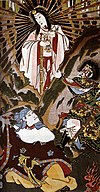| Ryūtōsan Shrine | |
|---|---|
 | |
| Religion | |
| Affiliation | Shinto |
| Deity | Ōmononushi (Konpira Gongen) Kunitama Okami Amaterasu Okami |
| Year consecrated | 1678 |
| Location | |
| Geographic coordinates | 35°06′03″N 129°01′57″E / 35.1008°N 129.0325°E / 35.1008; 129.0325 |
| Location relative to modern-day Busan | |
Ryūtōsan Shrine (龍頭山神社) was a Shinto shrine in Korea. It is the earliest shinto shrine in Korea built by workers of the local Japan House trade office in 1678. Such shinto may have served a purpose of expressing and maintaining a Japanese identity outside of Japan, while the Japanese and Korean people lived relatively close during this period.
It was a Kotohira shrine dedicated to Ōmononushi and the protection of sailors. In addition it, alongside all other nationally ranked shinto shrines in Korea enshrined Amaterasu and Kunitama as a pair.
It was originally called Kotohira shrine (金刀比羅神社), before being renamed Ryūtōsan Shrine (龍頭山神社, Ryūtōsan Jinja).
It was destroyed after the liberation of Korea. Its former site is now part of Yongdusan Park.
References
- ^ Shimizu, Karli; Rambelli, Fabio (2022-10-06). Overseas Shinto Shrines: Religion, Secularity and the Japanese Empire. London New York (N.Y.) Oxford: Bloomsbury Academic. ISBN 978-1-350-23498-7.
- ^ Nakajima, Michio (2010). "Shinto Deities That Crossed the Sea: Japan's" Overseas Shrines," 1868 to 1945". Japanese Journal of Religious Studies. 37 (1): 21–46. JSTOR 27822898. Retrieved 31 January 2016.
- Grisafi, John G. "Shintō in Colonial Korea: A Broadening Narrative of Imperial Era Shintō".
{{cite journal}}: Cite journal requires|journal=(help)
This article related to religion in Korea is a stub. You can help Misplaced Pages by expanding it. |
| Shinmei shrines | ||||||
|---|---|---|---|---|---|---|
| Gods |
|  | ||||
| Places | ||||||
| Kotohira Faith | ||
|---|---|---|
| Main Deities |  | |
| Main shrines | ||
| Branch shrines | ||
| misc | ||